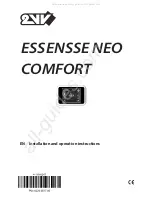
0
1
2
3
4
5
6
7
Y
X
BANK 1
BANK 0
SHORT PELS
LONG PELS
MASK
BITS
M
BANK3
Z
X
Y
2
1 3
2
1 1
2
1 1
2
1 3
0
68483-04.EPS
Figure 2 : Cyclical Drawing Coordinates to Display Memory Mapping
8
8
8
8
Z
32
X
Y
0
1
2
3
THE MEMORY WORD
BANK 0
BANK 1
BANK 2
BANK 3
7
4 BANKS OF 4 BIT PLANES EACH
68483-05.EPS
Figure 3 : The Display Memory Addressing Space
II - COMMANDS
II.1 - Introduction
The command set is strongly organized in five
subset or command types.
DRAWING COMMANDS :
- LINEAR (line, arc)
- AREA (rectangle, trapezium, polygon, polyarc)
- PRINT CELL (print character, print object)
ACCESS COMMANDS
CONTROL COMMANDS (move cursor, abort)
The commands are parametered ; this means that
any command can be executed with options freely
selected out of a given option set. This option set
is common for any command of a given type. For
example, any drawing command may be parame-
tered for destination mask bit use.
The command code also defines the command
type and its parameters. A command is completely
defined when a value has been set for each of its
arguments.
These arguments are :
- the geometric arguments given in the drawing
coordinate system for every drawing command.
They are automatically mapped into the destina-
tion frame buffer ;
- the parametric values are the values required by
the selected parameters ;
- the attribute values are the other values required
by a drawing command ; colors or scaling factors
for example ;
- the display memory addresses.
The command code is specified in register R0.
Before initiating a command execution, each argu-
ment must be specified in its dedicated register : -
an Xd, Yd drawing coordinate pair for example, is
always located in registers R14, R15.
The monitoring of a command execution is done by
reading the status register R12 or using the IRQ
signal.
TS68483A
6/30







































